In 1990-1991, Keith Connell brought over another line of pigs which he called North American Potbellies (NAPs) to differentiate them from the original Connell Line. While the original Connell Line came from pigs that were third generation (or more) Swedish stock with no German blood at all, the NAPs came from all over Europe — mainly Austria and Germany.
In looking at the pictures, it is clear that the NAPs were larger pigs with very thick legs. To breed them down to size, Keith Connell bred them with the Connell line, producing the show stock that is popular even today. It is believed that all the original NAPs are now gone, and very few, if any, second generation NAP pigs are alive today.
Anna
Pigs grow till they are 3 to 4 years old and the average weight is between 90-150 pounds, with some growing larger than that. Although that may seem large, remember that their body fat is dense and, in comparison to a farm hog, they are miniature.

Bette
You must pig-proof your home, pen, or yard. When you have a pig as a pet, it is like living with a two year old child, as they love to investigate. Their little minds grow bored and they need to be stimulated through toys, games, and training.

Doris
Pigs can become aggressive if they are not trained and properly cared for. Since pigs are herd animals and naturally set a “pecking order,” it is best to have a pair of pigs, if possible. Either way, when you are “tried,” you need to be firm and let the pig know that YOU are “top hog” in the herd, not the other way around!
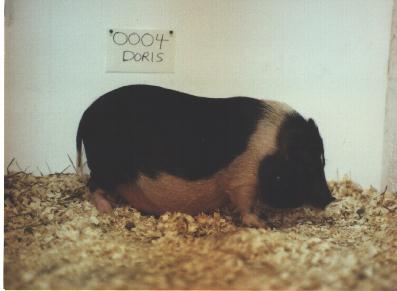
Ernst
You need to locate a vet in your area that specializes in potbellied pigs. Because of their unique physiology, veterinary care that works with farm hogs can kill your pet. Not all vets know how to treat pots, and not all vets will even agree to treat them. Do your homework before you bring one home so you won’t have to rush around looking for a vet with a sick pig on your hands.

Fiona
Potbellied pigs need special pig pellets made for them, not for farm hogs. Also, lots of fresh vegetables, and limited fruit as sugar must be carefully controlled in their diet. An overweight pig is not a healthy pig, and potbellies gain weight rapidly.
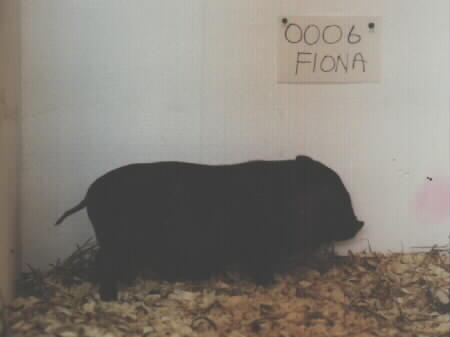
Gina
Pigs should be halter-trained as soon as possible. This will help when transporting your pig to a veterinarian when sick or in need of their annual shots and wormings. Also, don’t forget to keep those hooves and tusks trimmed on a yearly basis!

Hellena
Pigs need different kinds of vaccinations to protect them from swine diseases. Please talk to your vet to see what shots are needed and when they are needed. Remember, when crossing state lines with your pet, most states require a pseudorabies and brucellosis test and a health certificate. Don’t lose your pig because you wanted to “take the chance” of getting away without testing your pig first!

Irene
Pigs cannot be left alone when vacationing or visiting overnight. You will need to find a “pig-sitter” or boarding place that is safe for your pet. Arrangements need to be made well in advance to avoid last-minute hassles and frustrations.
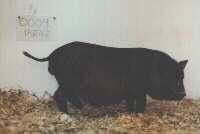
Julie
Pigs make good pets because of a variety of reasons. Pigs are flea-free; not likely to cause allergic reactions to humans like dogs and cats; and are low maintenance pets. They are virtually odor-free, clean, easily housebroken, intelligent, and highly trainable.

Kirston

Lotti
n addition to a quality potbellied pig food like Ralston Purina’s Mazuri, vegetables and limited fruit (for fiber), and a constant supply of water, it is recommended that you supplement their diet with vitamins A and E and Selenium. Many pet owners give their pigs a children’s chewable multi-vitamin each day in addition to their daily food supply.
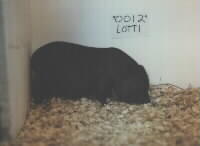
Monique
The expression “sweat like a pig” is untrue. Pigs have virtually NO sweat glands and are very susceptible to heat. They also deal poorly with cold. A warm place in the winter and a cool place in the summer is best. Make sure that “outside time” during extreme temperatures is limited and that the pig is kept at a moderate temperature to avoid those costly vet trips.
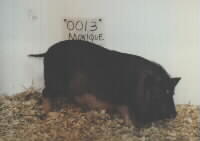
Nancy
Pigs respond very well to training and “behavior modification” techniques. They can easily be taught tricks by having routine physical contact with their owners, reassurances in a pleasant tone of voice, using short simple commands repeated frequently, and rewarding desired behavior with a treat like dried fruit or dry cereal.

Oprah
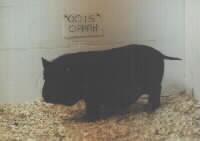
Qantas
It is very important to find out local zoning laws BEFORE you get a pet pig. Many communities make no distinction between miniature pet pigs and farm swine, and zoning battles can be quite costly and heartbreaking. To a zoning board, there may be no difference between your precious pet and the country hog-farmer’s herd. Do your homework first and save yourself the grief!
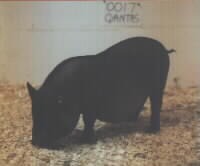
Raquel
If, after learning the facts and checking with your community’s zoning officials, you decide that you are ready to make the commitment to pet pig parenting, please consider adopting a rescue pig from a sanctuary or shelter. There are many pigs in need of homes that are eager to give you their complete love and devotion in exchange for your love and care! Many of these pigs are already trained, so your job is easier.
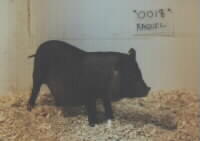
Sinatra
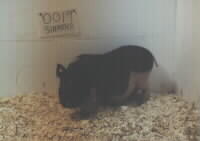
Tammy Faye
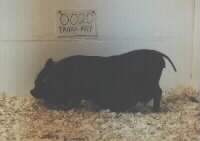
Ursula
Many people think that “Babe,” the piglet used in the movies, was a potbelly. Babe was not. Babe was a feral piglet. Although the movies are enjoyable and entertaining, many people seeing them think that there are pigs available that will remain that cute and tiny. Two or three years later, when their untrained rooter tops the scales at over 125-150 pounds, the pig is abandoned. Please get the facts BEFORE you get the pig! Be a part of the informed solution, not the problem! Thank you!
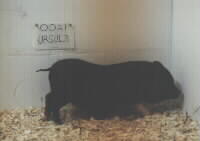
Vana
We held our first Florida Potbellied Pig Conference in Fort Myers, Florida on Saturday, January 23, 1999 at the Radisson Inn. The conference featured speakers from many different backgrounds and disciplines. The food was great, the fellowship was greater, and most left with the realization that this was just the beginning! Hope you didn’t miss it!
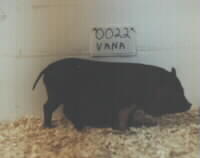
Walter

Grown NAP Pigs
Julie
 |
 |
Julie and Sinatra
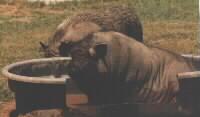
Lotti
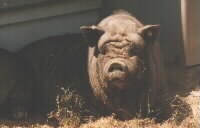
Sinatra
 |
 |
Irene
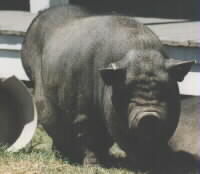
Irene and Sinatra
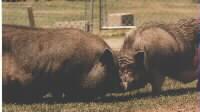
Unidentified Pig
